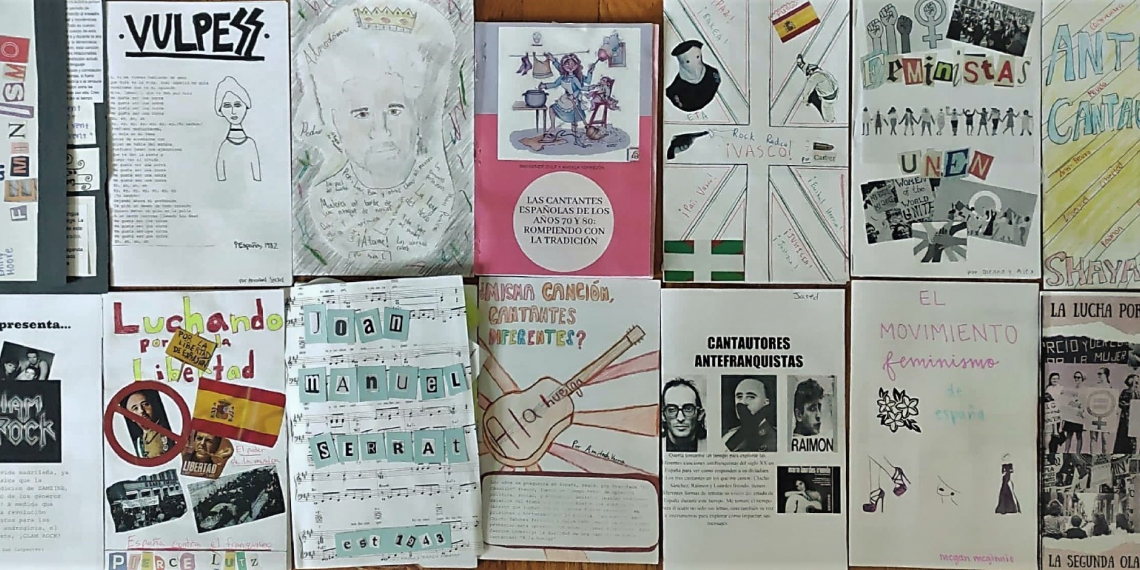Elia Romera Figueroa
In Spring 2022, during my fifth year as a Ph.D. Candidate in the Romance Studies Department, I had the opportunity to design and teach a course in my major field, Spanish Cultural Studies. As a language learner myself, I often felt that songs and music videos were reduced to occasional listening for leisure or fill-in-the-blank exercises, without considering their potential for critical thinking while practicing a second language. Influenced by my engagement in Sound Studies, I wanted to place music, performance, and sound at the center of class contents and at the core of assignments. However, I struggled to decide what were the best “sonic assignments.”
I asked myself this question to imagine assignments beyond the written word in isolation (traditional written essays, blog posts, written exams, etc.) Some instances of what I had in mind include the sonic dictionary (used in language courses by Duke Instructor Silvia Serrano) or the many attempts to include podcasts in a course, which led Emma Davenport to design the Podcast Pedagogy toolkit. In fact, podcasts seemed at first a particularly apt learning tool for my course, Sonic Youth: Spanish Music and Politics (1960-2022), centered on song’s analyses from a cultural-historical perspective. The course’s main objective was learning to think critically and historically in Spanish about youth cultures and their music.

Playlists and Fanzines – Research and composition across media
As I was making up my mind about podcasting, I came up with two fitting projects: annotated music playlists and fanzines, two thematically appropriate and authentic assessments of learning for this course. In a novel way, these assignments exercised key skills for cultural analyses and composition, such as close reading/listening techniques and structural organization. For instance, in drafting the fanzines, students submitted a storyboard to help them organize their material visually. Furthermore, both assignments offered students a chance to reflect on music through mediums that have been popularly used to exchange knowledge about music at specific historical times.
Music Interviews – Public Engagement
With these three projects in mind (playlists, fanzines, and podcasts), I became a fellow at Duke’s Language, Arts and Media Program (LAMP). In my first conversations with Prof. Kristen Neuschel, I struggled to speak about how the podcast project would work, which helped me understand that I was missing teamwork! Editing the podcast would have been very time-consuming, and learning this technology was not at the core of this course’s objective. Thus, I turned the initial podcast project into a public engagement assignment, aligning with LAMP’s goals (research, composition across media, and public engagement.) Music interviews were more fitting than the podcast assignment because the former was done in collaboration with the humanities research group PoeMAS, co-directed by Professors Clara I. Martínez Cantón and Guillermo Laín Corona, from UNED University in Spain. In PoeMAS, we run a radio music show Música con verso: conversaciones con… which counts on professionals to record it (Miguel Minaya Vara) and edit it (Ana Ventureira Pedrosa). Consequently, students could focus on writing the interviews since the technical support was handled for them. Student’s work involved song analyses and research about the artists, mainly through their social media platforms.
We interviewed three artists studied in class: folk singer Sheila Blanco, Galician duet Caamaño&Ameixeiras, and guitar player and vocalist Román Buho from the bands Tongo Banda and Papawanda. The principal challenge I had was deciding who should conduct the conversations. As it was a pilot program in PoeMAs, we decided I would read the questions written by students, except for the last one, which was asked by a representative from each group. Nevertheless, the entire team was present during their online recordings to experience participating in their radio interview. To finish the project, students wrote a short reflection, connecting the answers provided by the artists with class content.
Students remained engaged and enthusiastic throughout these three assignments while researching and composing in Spanish. This outcome encourages me to continue improving these "sonic assignments" (instructions, expectations, rubrics). For instance, now that I am more familiar with recording music interviews, I will offer students the chance to conduct the interviews by themselves. The pace of these interviews, which are not live-broadcasted and have intensive editing, should allow 300-level students to take control of the entire process. Also, it would be interesting to explore if local radio stations in Durham have music programs in Spanish and if they would be willing to explore similar collaborations since, for the interviewed artists, this international exposure could be an incentive to participate. Stay tuned!
IMAGE CREDIT: Photo by Elia Romera Figueroa.
ABOUT THE AUTHOR: Elia Romera Figueroa is a PhD Candidate in the Department of Romance Studies (Spanish Track) at Duke University. She has taught different language levels of Spanish at Duke, won a Bass Instructor of Record Fellowship to teach Introduction to Literature, Film, and Popular Culture in Latin America and Spain in Fall 2021 and, this Spring 2022, has taught a self-designed new course titled Sonic Youth: Spanish Music and Politics - 1960s-2022.